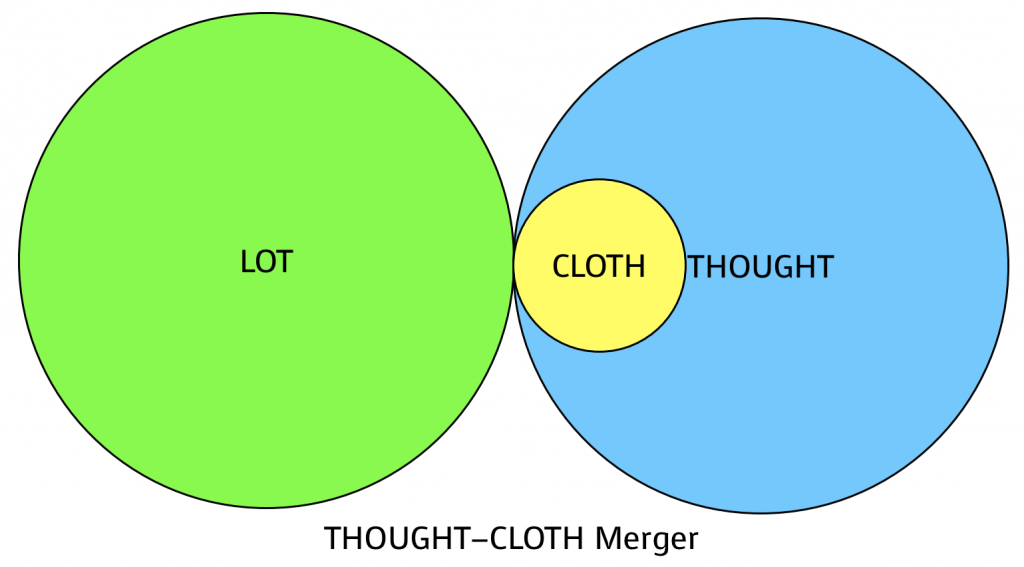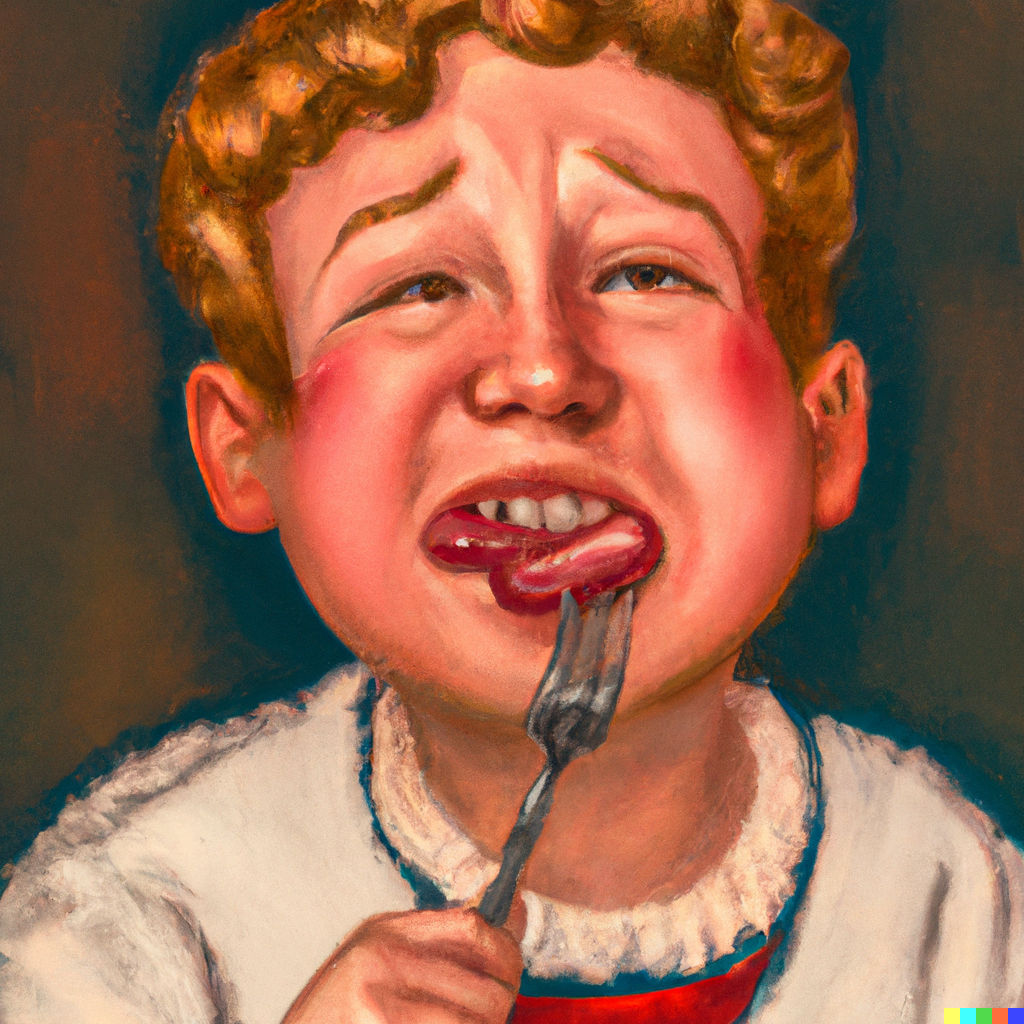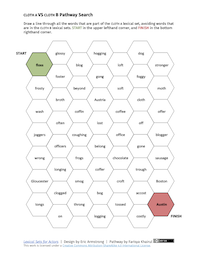8 The CLOTH Lexical Set

The cloth lexical set is part of the group of Checked vowels that is only capable of being in stressed syllables. Because it is Checked, it can only exist when it is followed by a consonant. In fact, cloth must be followed by specific consonants, otherwise the vowel is likely to be part of lot. For example, the word cloth is a part of cloth (of course it is!) because it ends in the ‹th›-sound, the voiceless dental fricative /θ/, while clot is part of lot because it ends in /t/, the voiceless alveolar stop. The consonant that follows the vowel is the determining factor, and I’ll lay out the environments that make that so when we discuss Spellings below.
cloth is a Lexical Set that behaves rather strangely, as it never has its own vowel sound: it always shares with either the lot or thought Lexical Sets.


There are many options for mergers in the open-back region of the vowel space, so overlaps can be quite complex. For example, you might have a lot/cloth/thought/north/force merger alongside a bath/palm/start merger in some parts of Australia; you might get a cloth/thought merger with a lot/palm merger in several regions of the United States.

cloth behaves differently in different accents. In the UK, cloth is more commonly merged with lot today; historically, it was more likely to be merged with thought (which is also merged with north/force.) This merger was frequently associated with traditional Received Pronunciation (RP); as that “high status” accent becomes less fashionable, and as older speakers die off, cloth words become less noticeable, as they are blending in with lot. Meanwhile, in the US, cloth is frequently merged with thought and has a larger inventory of words that are part of the set.
As we have seen in other Lexical Sets, cloth is broken into 3 subgroupings. Groups Ⓐ and Ⓑ are followed by similar, but not always identical consonants; the words that belong to one group over the other can seem somewhat arbitrary. Meanwhile, Group Ⓒ has its vowel preceding /r/ before another vowel. Different accents have different ways of implementing the various subgroupings. For example—
In Traditional RP:
- Group Ⓐ is merged with thought;
- Groups Ⓑ & Ⓒ are merged with lot.
In some accents in the US, such as so-called General American:
- Groups Ⓐ & Ⓑ are merged with thought;
- Group Ⓒ is split, so that some words are merged with start while others are merged with north/force.
In Canada:
- Groups Ⓐ & Ⓑ are merged with palm/lot
- Group Ⓒ has all words spelled ‹or/orr› merged with north/force.
If you have a merger of two or more Lexical Sets, you’ll need to memorize the most common instances of the set (or even just a subgroup), and the environments in which they are found, as figuring out where these words belong is non-obvious. For example, many words in Group Ⓑ are similar in their spelling to words in Group Ⓐ, and so need to be memorized. For example, why are broth, cross, Austin in Group Ⓐ, while moth, boss, sausage are in Group Ⓑ? Though there are historical reasons why these words are sorted into these groups, the answer to why is simply this: because they are.
- ☑️ Checked: cannot exist without a following consonant
- Used in stressed syllables only
Spellings
Ⓐ o, au + fricative: merged with thought in GenAm and older RP;
These spellings require a following voiceless fricative, generally /f/ (off, cough), /θ/ (moth), /s/ (toss), /ft/ (soft), or /st/ (lost)
Ⓑ o + fricative or velar: merged with thought in GenAm and with lot in RP;
These spellings require either:
- a following voiceless fricative, generally /f/ (coffee), /θ/ (moth), /ʃ/ (wash), /s/ (moss), or /st/ (foster), OR
- a following velar nasal, ‹-ng›/ŋ/ (long)
- a following velar plosive, /k, ɡ/ (chocolate, dog), though this is much more variable in its usage, and should be checked with an accent informant.
Ⓒ orV, orrV, lawrV, laurV, warrV, quarrV: merged with start and/or north/force in GenAm, & with lot in RP;
These spellings are mostly
- ‹or› or ‹orr› before another vowel (origin, orange, borrow, horrid),
- ‹awr› or ‹aur› before another vowel (Lawrence, Laurence, laurel), or
- /w/ before ‹arr› before another vowel (quarrel, warrant)
Along the Atlantic seaboard of the United States, all of cloth Ⓒ is merged with start. Inland, through much of the Midwest and the West, cloth Ⓒ is primarily merged with north/force, though ‹orr› words as in sorry, borrow, tomorrow are said with start. In Canada, all of cloth C is merged with north/force.
Pronunciations
As cloth Ⓐ & Ⓑ are either merged with lot or thought, it is important to consider the pronunciations of those two. In accents with a difference between the two sets, lot [a ~ ɑ ~ ɒ] is generally more open and forward than thought [ɑ ~ ɒ ~ ɔ].
For more pronunciation options to explore, see lot and thought.
In accents where there is a merger between lot and thought, and yet a contrast with palm [ɑ̟ ] such as one finds in Philadelphia, cloth will match lot and thought [ɒ̝ ~ ɑ̞]. In near-merger settings, where lot, thought and palm are almost completely the same, as we hear in most of Canada, there may still be a few cloth words that are different. For example, ‹ong› words, with cloth before the velar nasal /ŋ/, are in the range of [ɒŋ]. In Inland Northern accents where lot [a] is more advanced than palm [ɑ̟], cloth merges with thought in the range of [ɒ ~ ɔ̞]
With cloth being so difficult to distinguish from lot, thought and palm, many L2 speakers merge it with lot and/or thought and/or palm. For others, a spelling pronunciation—usually a merger with goat— in the range of [o ~ ɔ] is not uncommon.
Personal Pronunciation
Do you merge cloth words with lot or thought? Let’s try to figure that out. Compare these words, and see whether their vowels match.
| lot | cloth | thought |
| bot | Ⓐ broth | brought |
| Goth | Ⓐ froth | fraught |
| con | Ⓐ cough | cause |
| crop | Ⓐ croft | crawl |
| sot | Ⓐ soft | sought |
| bot | Ⓑ bong | bought |
| rot | Ⓑ wrong | rought |
Are lot and cloth the same, are cloth and thought the same, or are they all the same? If there are outliers, words that don’t fit the pattern, don’t fret! It is quite common in a personal idiolect for a word here or there to not match the “standard” Lexical Sets.
Based on this knowledge, for cloth Ⓐ and Ⓑ you can use the details from the Personal Pronunciation section of lot, or thought to determine how to transcribe your own speech. For cloth Ⓒ, before /r/, we have mergers with either start, north, or force. See those Lexical Sets for details on pronunciation/transcription options.
Alternate Pronunciations
Experiment with the Word Lists, Phrases and Sentences with the following vowels:
Word Lists, sorted by consonants that follow
KEY: ◾︎cloth in stressed syllable
⚠︎ These words are highly variable. Just because they’re listed here doesn’t make them right for all accents!
PLOSIVES and AFFRICATES
Note that many accents merge these words with lot, not thought, and for those that do merge them with thought, they do not necessarily behave consistently.
-k
-g
NASALS
-m
-n
-ŋ
FRICATIVES
cloth only occurs before voiceless fricatives, never before voiced ones.
-s
-ʃ
-θ
-f
APPROXIMANTS
The cloth vowel followed by /r/, followed by unstressed comma (schwa /ə/), happy, kit, or goat, is Group Ⓒ, and is only used in the United States. Words that are members of this group are frequently difficult to identify, as they may easily merge with start, lot, or north/force. Note that some North American speakers may have Group Ⓐ & Ⓑ words with cloth, and Group Ⓒ words merged with something else.
-ɹ* (see start, north and force for options)
correlate, correspond, horrid, horrible, horrify, Morris, porridge, sorrel
Laurence/Lawrence, laurel
quarrel, quarry, warrant, warren, warrior
borrow, horror, morrow, sorrow, tomorrow, sorry
🍁 Many of these words are shibboleths for Canadian speakers, who use north/force; when working in a US context, start is required for many accents.
Short Phrases Ⓐ or Ⓑ
Underlined cloth Ⓐ, cloth Ⓑ; lot and thought words are marked with superscript l & t, lotl, and thoughtt
- Hotl broth
- You’re wrong.
- The lost Austen book.
- Melt the chocolate in your coffee.
- You’ve gone above and beyond.
- Moth-eaten cloth
- Lay the coffin in the trough softly.
- The wash-watert is frothy.
- They’re flip-flopsl, notl thongs!
- Across the frost-covered lawnt.
Short Phrases Ⓐ, Ⓑ, Ⓒ
Underlined cloth Ⓐ, cloth Ⓑ, cloth Ⓒ
- He lacks moral authority.
- Lawrence borrowed my office.
- The orange coral from Oregon.
- The tomorrow’s orator
- The offer in the majority position
- I often visit my florist’s loft.
- The Austrian sausage is horrible.
- Florida orange juice
- Categorically, the tongs belong to me.
- Wash it with a soft cloth.

Sentences
Level 1
Short with 2-3 words, underlined cloth Ⓐ, cloth Ⓑ, cloth Ⓒ
- I gotl lost in Boston.
- Frost covered the moss.
- Ross from Australia loves coffee.
- Foster often coughs into his elbow.
- He was laid off from the Gloucester office.
Level 2
Short with 3-5 words, underlined cloth Ⓐ, cloth Ⓑ, cloth Ⓒ
- The Austrian flossed her teeth till they were glossy.
- They fed the orange moth some broth.
- The coughing officer felt the soft inside of the coffin.
- Laurel and Austin quarrelled often.
- She tossed off the horrible song quickly.
Level 3
Medium with 3-4 words, not underlined
- The majority of the crosses at the cemetery came from this quarry.
- There’s a warrant in Florida for the woman from Oregon.
- My boss softly sang a horrible song.
- He spoke metaphorically about the cost of such a loss.
- The chef tossed a lotl of sorrel in the sour porridge.
Level 4
Hard with 4-6 words, not underlined
- Senator Warren offered to cover the cost of the loss.
- Never borrow lip gloss without washing it first.
- The scent of joss sticks waftedl across the sorry doss house.
- The Thane of Ross took the wrong coffer on the morrow to Norwich.
- Cross the fosse by way of the long bridge to get to the watert trough in the croft.
Mergers with cloth Ⓐ, Ⓑ
cloth is all mergers, all the time! Primarily the challenge is in figuring out whether cloth in a new accent you’re learning is merged in the way your accent merges it, or not.
The lot–cloth Merger is perhaps the most common merger that people have these days, in Englishes around the globe. If you merge cloth with lot in your own personal accent, learning to identify cloth words is challenging, as there aren’t a lot of spelling clues as to which words are part of the set. Add to this the challenge of Distribution: some accents don’t necessarily have precisely the same words as part of their version of a set. In these cases, having an informant who speaks the accent who can help you identify whether a word should be merged with thought or lot is very helpful.
Having thethought–cloth Merger in your personal accent, which is common in much of the US, is perhaps a little easier. When working on an accent with the lot–cloth Merger, learning to identify which words might shift to lot is fortunately fairly easy, as their “short-o” spellings generally makes them stand out from other thought words.
Those with a 3-way thought–lot–cloth Merger in your personal speech pattern, which happens in Canada and in parts of the West of the US, you’re going to have a particularly hard time decoding which words go where. And those with a 4-way thought–lot–cloth–palm Merger perhaps have it hardest of all! Be sure to tackle thought, lot, and palm before trying to make the following contrasts distinct.
cloth Ⓐ, Ⓑ Contrast Sentences with lot
- Merge all 3 with palm (and start, if non-rhotic) as in Canadian;
- Merge thought with cloth Ⓐ, and lot with cloth Ⓑ as in RP;
- Merge cloth Ⓐ and cloth Ⓑ with thought, while keepinɡ lot distinct, as in GenAm.
-
- The boss botched his toss to the tot.
- Scott crossed his hands over his crotch
- The hot coffee made Tom cough.
- I’m often bothered by the fonts used in Jane Austen novels.
- The quality of the odd Australian sausage is off.
cloth Ⓐ, Ⓑ Contrast Sentences with thought
- Merge all 3 with palm (and start, if non-rhotic) as in Canadian;
- Merge thought with Ⓐ, and lot with Ⓑ as in RP;
- Merge cloth Ⓐ and cloth Ⓑ with thought, while merging lotl with palmp as in GenAm.
- Saul didn’t wash the soft cloths with his laundry.
- The cost to install the hotl water softener in the office was appalling.
- Robl saw that frothing milk for coffee is notl easy.
- Shawn was appalled by the strong taste of guavap in the sauce.
- Tawny took off her uncomfortable brap and thong, and tossed them away.
Mergers with cloth Ⓒ
It is perhaps most helpful to think of whether cloth Ⓒ in any particular accent merges with force, north, or start, rather than with thought, lot, or palm. For many accents, there is a parallelism between these sets. Historically speaking, these lexical sets went from more close pronunciations to more open, in the range of /or, ɔr, ɑr/. I’ve single-underlined ‹orr› words here, and double-underlined ‹or› words.
- 🍁 Merge north/force and both cloth Ⓒ categories; make starts distinct, as in Canadian;
- Merge cloth Ⓒ-orr with starts, and cloth Ⓒ-or with northn/forcef, as in GenAm;
- Merge cloth Ⓒ-orr & cloth Ⓒ-or with starts; make northnand forcefdistinct, as in US Atlantic states.
-
- I’m sorry I soiled your sorel-colored saris—are you soref about it?
- I’m boredn about hearing how you’ll borrow a bars of soap & my boarf hair brush.
- She heard the whoref scream herself hoarsef at the horror movie with the horsen.
- Tomorrow, Morris will put moref morphinen in the marmalades.
- Ares our(s) orange orbsn horrible ornamentsn, orn ares they made of molten oref?
Review
Pathway Puzzles
Pathway Puzzles allow you to practice finding members of a lexical set. Choose the next cell with the FIRST lexical set word to make a pathway from the START of the puzzle down to the FINISH. Open the KEY document to see the solution, and check your work. Pathway Puzzles were created by Farisya Khairul, through support from a AMPD Minor Research Grant.
cloth Ⓐ – cloth Ⓑ Pathway Puzzle | KEY
cloth Ⓑ – cloth Ⓐ (- lot) Pathway Puzzle | KEY


